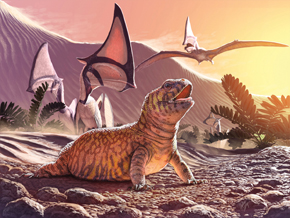
J. Csotonyi Gueragama sulamericana: the first acrodont lizard to be discovered in South AmericaJ. Csotonyi
Well-preserved fossilized pieces of a prehistoric jawbone found in the city of Cruzeiro do Oeste, northwest Paraná State, are helping Brazilian and Canadian researchers better understand the origin of iguanian lizards in South America. Over 1.700 species of iguanians exist today and many others are already extinct. The new species, Gueragama sulamericana, lived in southern Brazil approximately 80 million years ago, according to the study (Nature Communications, August 26, 2015). Analyses indicate that it belonged to a group of lizards known as acrodonts, previously observed only in Asia, Africa, and Europe. The discovery of G. sulamericana by researchers from the University of Alberta (Canada), Contestado University (state of Santa Catarina), and the National Museum at the Federal University of Rio de Janeiro (UFRJ) suggests that these reptiles dispersed throughout the Southern Hemisphere far earlier than once imagined. The data also indicates that acrodonts achieved a worldwide distribution before the Cenozoic Era, the period encompassing the last 66 million years. “Like modern acrodonts living in similar habitats in North Africa and the Middle East, Gueragama probably lived in burrows to avoid extreme temperatures during at least part of the day,” says Brazilian paleontologist Tiago Rodrigues Simões, a Ph.D. student at the University of Alberta and principal author of the study about the new acrodont fossil.
Republish